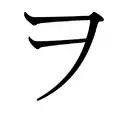ヲ
 | ||||||||
| ||||||||
| ||||||||
| ||||||||
Japanese
| Stroke order | |||
|---|---|---|---|
Etymology
Simplified in the Heian period from the man'yōgana kanji 乎.
Pronunciation
- IPA(key): [ɰᵝo̞] (obsolete)
- IPA(key): [o̞]
Syllable
ヲ (romaji wo, alternative romaji o)
- (obsolete) The katakana syllable ヲ (wo). Its equivalent in hiragana is を (wo). It is the forty-seventh syllable in the gojūon order; its position is ワ行オ段 (wa-gyō o-dan, “row wa, section o”).
- (used as a particle) The katakana syllable ヲ (o). Its equivalent in hiragana is を (o). It is the forty-seventh syllable in the gojūon order; its position is ワ行オ段 (wa-gyō o-dan, “row wa, section o”).
Usage notes
- Unlike the hiragana system, used for Japanese language words that kanji does not cover, the katakana syllabary is used primarily for transcription of foreign language words into Japanese and the writing of loan words (collectively gairaigo), as well as to represent onomatopoeias, technical and scientific terms, and the names of plants, animals, and minerals. It is also occasionally used colloquially in some words for emphasis. Names of Japanese companies, as well as certain Japanese language words, are also sometimes written in katakana rather than the other systems. Formerly, female given names were written in katakana. [edit]
- Because the hiragana equivalent, を, is used almost exclusively as the direct object particle, and particles are usually written in hiragana, ヲ is seldom used.
This article is issued from Wiktionary. The text is licensed under Creative Commons - Attribution - Sharealike. Additional terms may apply for the media files.